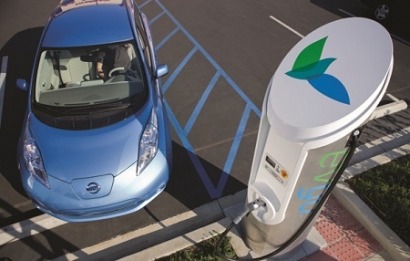
Market intelligence firm, Pike Research, has published optimistic forecasts for the future of the EV charging market. The company says that significant growth in EV sales, will be accompanied by an increase in sales of chargers as, in many markets, the majority of customers who purchase a PEV will purchase charging equipment for their home.
At the same time, many cities and states are promoting the use of PEVs and installing EV charging systems as a means of reducing urban emissions. According to a recent Pike Research report, more than 1.5 million locations to charge vehicles will be available in the United States by 2017, with a total of 7.7 million locations worldwide.
This will translate into revenues of more than $4.3 billion for makers of electric vehicle charging equipment by 2017, the market intelligence firm forecasts, up from $400 million in 2011, representing a compound annual growth rate of 49%.
“Prices for EV charging equipment will fall by 37% through 2017 as costs are driven down by competition from large electronics companies as well as volume production,” says research director John Gartner. “With each new electric vehicle model that gets launched, makers of charging equipment, city planners, and retailers gain an increased sense that EVs are here to stay. This will encourage both the production and purchase of charging systems.”
The deployment of EV charging equipment will also have implications for electric utilities’ business models. The impact of power delivered through EV charging units could shorten the lifespan of some neighborhood distribution equipment, such as transformers or power lines. Some utilities are offering less expensive EV charging rates and time of use (TOU) pricing, with power purchased overnight costing a fraction of the peak power price. The benefits of off-peak charging will encourage nearly all equipment purchases to be smart charging units that can be programmed remotely. A number of pioneering utilities are beginning to invest in information technology (IT) and other smart grid equipment to accommodate the increased load.
Despite limited sales in 2012
Pike Research's upbeat predictions for the future of the EV market comes despite findings of a white paper published by the firm, which reveal that many potential buyers will hold off on purchases of EVs during 2012 due to the premium pricing of the vehicles.
Nissan raised the price of the Leaf for 2012, and while the 2012 Chevrolet Volt will sell for $1,000 less, the car comes without several features that were previously standard but are now options. According to data from Pike Research’s annual Electric Vehicle Consumer Survey, the optimal price for a plug-in electric vehicle (PEV) to engage consumers is $23,750. With the 2012 Toyota Prius PHEV ($32,000), the Honda Fit BEV ($36,625), and the Ford Focus EV ($39,995) all north of $30,000 (before federal incentives), consumers hoping for an affordable EV ride have been left wanting. These relatively high selling prices will constrain the market for PEVs in 2012. The white paper, which includes 10 predictions about the EV market in 2012, is available for free download on Pike Research’s website.
“Vehicles on sale in 2012 will not benefit from recent cost reductions in batteries,” says research director John Gartner. “The batteries in these vehicles were ordered before 2012, so any flexibility in reducing vehicle pricing will not occur until 2013 or 2014 at the earliest. Nevertheless, the global market for plug-in electric vehicles will grow to more than a quarter million vehicles in 2012 – a number sufficient to put an end to the ‘are they for real?’ speculation that has surrounded this market.”
Pike Research’s industry predictions for 2012 include the following:
For additional information:

